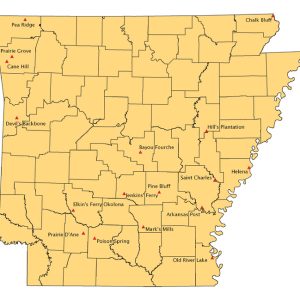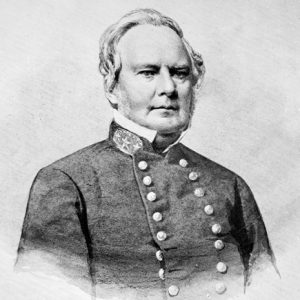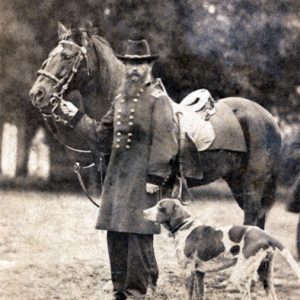calsfoundation@cals.org
Skirmish at Prairie D'Ane
aka: Battle of Gum Grove
|
Location: |
|
|
Campaign: |
|
|
Dates: |
April 9–13, 1864 |
|
Principal Commanders: |
Major General Frederick Steele (US); Major General Sterling Price (CS) |
|
Forces Engaged: |
Department of Arkansas (US); District of Arkansas (CS) |
|
Estimated Casualties: |
Unknown |
|
Result: |
Union victory |
The Skirmish at Prairie D’Ane was an April 1864 battle in which Confederate troops tried to stop a Union advance into southwestern Arkansas. It was the second engagement of the Camden Expedition.
After capturing Little Rock (Pulaski County) and Fort Smith (Sebastian County) in September 1863, Union forces were in control of much of the state. From these two occupied cities, Federal troops could launch an attack into southern Arkansas, northern Louisiana, and eastern Texas. In March 1864, the Union launched an attack on northwest Louisiana and eastern Texas from Arkansas and New Orleans, Louisiana. The attack launched from New Orleans became known as the Red River Campaign, while the invasion launched from Little Rock became known as the Camden Expedition.
On March 23, Major General Frederick Steele set out from Little Rock to help the Union column from New Orleans capture Shreveport, Louisiana, then the headquarters for the Confederate Trans-Mississippi. Steele arrived March 29 in Arkadelphia (Clark County) and waited for reinforcements from Fort Smith under Brigadier General John Thayer. After waiting three days, Steele had to continue his mission without the extra men. On April 1, Steele continued his expedition into south Arkansas, reaching the Little Missouri River on April 3. He was running low on rations and wanted to capture Camden (Ouachita County) to resupply his men. Camden was rumored to have a large supply of food. But Camden was occupied by the main body of the Confederate army in Arkansas, led by Major General Sterling Price. Steele decided to move toward Washington (Hempstead County)—then the Confederate capital of Arkansas—and draw Price’s army from Camden, leaving the town open for the taking. After crossing the Little Missouri and fighting the Engagement at Elkin’s Ferry on April 3–4, Steele continued toward Washington.
He pushed the Confederates back to Prairie D’Ane, where they took up defensive positions. Price’s main objective was to protect Washington. Brigadier Generals Joseph Shelby and John Marmaduke led the units that fought Steele at Elkin’s Ferry. Two cavalry brigades under Colonel Richard Gano reinforced them on April 6. On April 7, the rest of the Confederate forces in Camden further reinforced the units in the field. When the units from Camden also arrived, Price took control of the entire army. Federal troops were also receiving long-awaited reinforcements. After getting his army across the Little Missouri on April 4, Steele continued his advance on April 5. He soon halted his army again six miles from the Little Missouri when word reached him of Thayer’s approach. On April 9, Thayer finally reached Steele, and the combined armies continued their march. Thayer’s men were short of food, and Steele had to request rations to be sent immediately from Little Rock. On April 10, Steele’s men reached Prairie D’Ane.
The Confederates had been building earthworks for six days, and the Union troops immediately began building their own defensive positions about a mile away. Prairie D’Ane consists of about thirty square miles of open, rolling land surrounded by forests. For the next two days, the Union and Confederate armies exchanged an occasional artillery shell and engaged in limited skirmishing. Neither side wished to force a major engagement, and the bulk of the two armies received a short respite from the war. The men were able to relax and do everything from hunt rabbits to write letters home. Several small attacks were launched but did not accomplish anything; the last fighting died out about midnight on April 11. On April 11, Steele formed his army into a battle line that stretched more than two miles but did not move on the Confederates’ positions until the next day, when he found them abandoned. Price had withdrawn under cover of darkness to positions near Washington, where he prepared to defend the capital.
With the Confederate army defending Washington and leaving Camden undefended, Steele turned his troops to the east and moved on the city. His men entered the city on April 15 despite Confederate attacks along the column.
The Skirmish at Prairie D’Ane allowed Steele to confuse the Confederates and force them to defend Washington while Federal troops moved into Camden. Little loss of life resulted from the skirmish, but it was the turning point of the Camden Expedition. Without provisions, the Union advance into southwest Arkansas had been stopped and turned away. There was little hope of Steele’s reaching his ultimate objective of Shreveport and east Texas.
The battlefield at Prairie D’Ane remained in private hands for many years, looking much the same as it did at the time of the battle. On February 23, 2018, an acquisition ceremony was held to present the deed for the 808 acres of the battlefield to the Nevada County Depot and Museum.
For additional information:
Atkinson, J. H. “The Action at Prairie De Ann.” Arkansas Historical Quarterly 19 (Spring 1960): 40–50.
Bearss, Edwin C. Steele’s Retreat from Camden and the Battle of Jenkins’ Ferry. Little Rock: Eagle Press, 1990
DeBlack, Thomas A. With Fire and Sword: Arkansas, 1861–1874. Fayetteville: University of Arkansas Press, 2003.
David Sesser
Nevada County Depot and Museum
 Civil War Events Map
Civil War Events Map  Sterling Price
Sterling Price  Joseph Shelby
Joseph Shelby  Frederick Steele
Frederick Steele 




Comments
No comments on this entry yet.